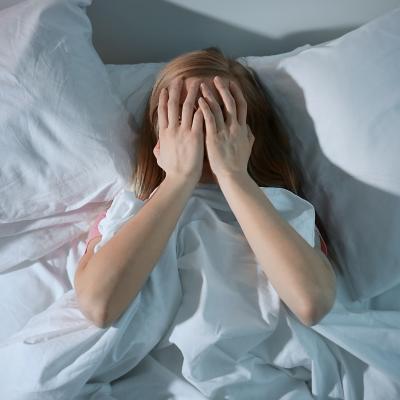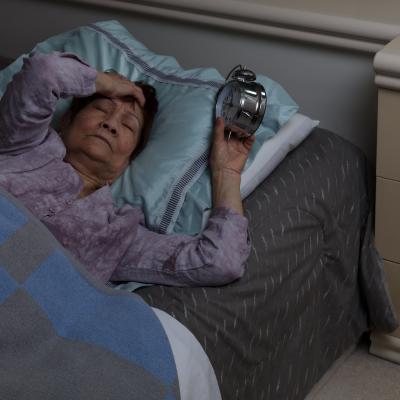The sensation of falling during sleep is a common phenomenon that many people have experienced. This sudden feeling can interrupt rest, causing discomfort when waking abruptly. Although often harmless, it generates curiosity and, in some cases, can provoke anxiety.
The phenomenon is related to an involuntary muscle spasm, also known as hypnic jerk, which occurs during the transition from light sleep to deeper sleep. Although it poses no health risks, understanding its causes and how to cope with it can improve sleep quality and reduce discomfort.

What causes the sensation of falling during sleep?
The sensation of falling during sleep is closely related to the relaxation of the body and the transition to sleep. During this stage, the brain may mistakenly interpret this relaxation as a signal of danger, triggering a startle reflex.
This phenomenon is often accompanied by involuntary muscle spasms, known as hypnic jerks. Although these spasms are brief, they can cause a sudden sensation of falling, waking the individual from sleep.
Stress, excessive fatigue, and the consumption of substances like caffeine can increase the frequency of these spasms. The more tense the body and mind are, the higher the chance of this type of reaction occurring at the beginning of sleep.
The phenomenon is not limited to any specific age group, although some people may experience it more frequently. Understanding the factors that contribute to the sensation of falling can be helpful in avoiding or reducing its impact.
How does the brain interpret relaxation during sleep?
When the brain perceives the body relaxing to enter deep sleep, it may interpret this state as a sensation of loss of control or imbalance. This mental alert can create a feeling of falling, which activates the startle reflex.
This reflex, a primitive response of the brain, would have been essential for the survival of our ancestors, who needed to stay alert to predators and other dangers. However, nowadays, this response can be triggered more sensitively during sleep.
The brain can confuse muscle relaxation with the sensation of imbalance, leading to an involuntary response of the nervous system. This mechanism is considered a misinterpretation of the body at rest.
The phenomenon occurs more frequently in the early stages of sleep, when the brain is still adjusting its sensory signals. This explains the abrupt sensation of falling during the transition to deep sleep.
Factors that influence the occurrence of hypnic jerks

Stress and anxiety are factors that can intensify hypnic jerks, making the brain more alert and prone to interpreting muscle relaxation as a signal of danger. The accumulated tension can contribute to this uncomfortable experience.
Additionally, sleep deprivation can alter normal sleep patterns, making the spasms more frequent. Excessive fatigue can affect the body’s circadian rhythm, making it more susceptible to these phenomena during the transition to sleep.
Caffeine or stimulant substance consumption also plays an important role. These substances affect the central nervous system, making the body more prone to involuntary reactions during the relaxation process before sleep.
The combination of these factors can significantly increase the intensity and frequency of hypnic jerks. Lifestyle changes, such as reducing the consumption of stimulants or improving sleep hygiene, can help minimize these episodes.
How to cope with the sensation of falling during sleep?
Coping with the sensation of falling can be challenging, but there are some strategies that can help reduce the frequency of spasms. Establishing a regular sleep routine is one of the most effective steps.
A relaxing sleep environment, with low light and no noise, can also help minimize spasms. Ensuring the room is comfortable contributes to a more peaceful sleep and reduces the likelihood of sudden awakenings.
Relaxation practices, such as meditation or deep breathing exercises, can help prepare the body and mind for a more restful night of sleep. This can decrease the feeling of anxiety, which in turn contributes to spasms.
Avoiding stimulant substances in the hours before sleep and reducing daily stress are also effective measures. These habit changes can have a positive impact on sleep quality and the frequency of hypnic jerks.
What is the sensation of falling during sleep?
The sensation of falling during sleep is a common experience that many people face at some point in their lives. This phenomenon is often described as a sudden sensation of falling, which wakes the person from a light sleep state. It may be accompanied by an involuntary muscle spasm, known as a hypnic jerk or sleep myoclonus. Although generally harmless, it can be unsettling and cause anxiety in some individuals.
Hypnic jerks occur during the transition from wakefulness to sleep, specifically in the early stages of non-REM sleep. During this stage, the body begins to relax, and body temperature decreases, preparing the individual for deep sleep. However, the brain may interpret this relaxation as a falling sensation, triggering a startle reflex that wakes the person. This sensation of falling may be more common in people who are stressed, fatigued, or have consumed caffeine or other stimulants before bed.
How do involuntary spasms during sleep work?
Involuntary spasms during sleep, or hypnic jerks, occur when the body transitions from wakefulness to sleep. During this period, the brain gradually begins to shut down sensory and motor systems, preparing the body for rest. In some individuals, this process can be interrupted by a sudden, involuntary muscle spasm. This spasm is typically brief and may be accompanied by a sensation of falling, which wakes the person.
The exact mechanism behind hypnic jerks is not fully understood, but it is believed to be related to the central nervous system. As the body begins to relax, the brain may mistakenly interpret this relaxation as a signal of danger, as if the body is falling. This can trigger a startle reflex, a primitive response dating back to our ancestors, who needed to remain alert for potential threats while sleeping in trees or dangerous environments.
Factors such as stress, anxiety, sleep deprivation, and the consumption of stimulant substances can increase the frequency and intensity of hypnic jerks. Stress and anxiety can keep the brain in a heightened state of alertness, making it more prone to misinterpreting relaxation as a falling signal. Similarly, sleep deprivation can disrupt normal sleep patterns, increasing the likelihood of hypnic jerks. Substances like caffeine and nicotine can affect the central nervous system, making the brain more susceptible to these spasms.
Although generally harmless, hypnic jerks may indicate that the body needs more rest or that stress levels are high. In rare cases, frequent and intense jerks may be a symptom of underlying sleep disorders, such as restless legs syndrome or sleep apnea. If the jerks interfere with sleep or quality of life, it may be helpful to consult a healthcare professional for a more thorough evaluation.
Advantages of understanding the sensation of falling during sleep

Understanding the sensation of falling during sleep can offer several advantages for overall well-being and sleep quality. Recognizing that hypnic jerks are a common and generally harmless occurrence can help alleviate the anxiety associated with this experience. Many people may unnecessarily worry about having a serious health problem when they experience this sensation. Knowing that it is a normal bodily response can provide peace of mind and reduce sleep-related stress.
Understanding the factors that contribute to hypnic jerks can help individuals make lifestyle adjustments to improve sleep quality. For example, reducing caffeine and nicotine intake, especially in the hours leading up to sleep, can decrease the frequency of jerks. Relaxation practices, such as meditation or breathing exercises, can help calm the mind and body before bed, reducing the likelihood of jerks during the transition to sleep.
Another benefit is the ability to identify when these jerks may signal an underlying health issue. Although generally harmless, in some cases, they may indicate sleep disorders or other medical conditions. Being aware of this possibility can encourage individuals to seek medical evaluation when necessary, ensuring they receive proper treatment to improve their health and overall well-being.
Understanding the sensation of falling during sleep can promote greater awareness of the importance of quality sleep. Many people underestimate the impact of sleep on mental and physical health, and recognizing the role hypnic jerks play in the sleep cycle can encourage positive changes in sleep habits. This may include establishing a consistent sleep routine, creating a comfortable sleep environment, and prioritizing adequate rest as part of a healthy lifestyle.
How to cope with the sensation of falling during sleep
Coping with the sensation of falling during sleep can be challenging, but there are several strategies that can help minimize the frequency and intensity of hypnic jerks. Here are some practical tips for managing this experience:
Establish a regular sleep routine: Going to bed and waking up at the same time every day can help regulate the body’s circadian rhythm and improve sleep quality.
Create a relaxing sleep environment: Make sure the room is dark, quiet, and at a comfortable temperature. Consider using eye masks, earplugs, or white noise machines if necessary.
Reduce caffeine and nicotine intake: Avoid consuming these substances in the hours leading up to sleep, as they can stimulate the nervous system and increase the likelihood of hypnic jerks.
Practice relaxation techniques: Deep breathing exercises, meditation, or yoga can help calm the mind and body before sleep, reducing stress and anxiety.
Avoid using electronics before bed: The blue light emitted by electronic devices can interfere with melatonin production and hinder sleep onset. Try turning off devices at least one hour before bed.
Consider behavioral therapy: If hypnic jerks are frequent and significantly disrupt sleep, behavioral therapy can help address underlying factors such as stress and anxiety.
Implementing these strategies can help reduce the occurrence of hypnic jerks and improve overall sleep quality. However, if the jerks persist or cause concern, it is important to consult a healthcare professional for a more thorough evaluation. This will ensure that any underlying condition is identified and treated properly, promoting healthier and more restorative sleep.
Frequently Asked Questions
What is the sensation of falling during sleep?
The sensation of falling during sleep is a sudden feeling that can wake us up abruptly. It feels like you are falling for a second.
Why do we feel the sensation of falling when falling asleep?
This happens when your muscles relax rapidly as you fall asleep. Your brain may interpret this as a fall.
Is the sensation of falling during sleep dangerous?
No, it is usually not dangerous. It is a natural response of the body when falling asleep. You are safe.
How can I avoid the sensation of falling when sleeping?
Relax before bed and try to avoid stress. A quiet environment and a sleep routine can help.
What is the technical term for the sensation of falling during sleep?
The technical term is “hypnic jerk.” It is a common and natural phenomenon in the process of falling asleep.
